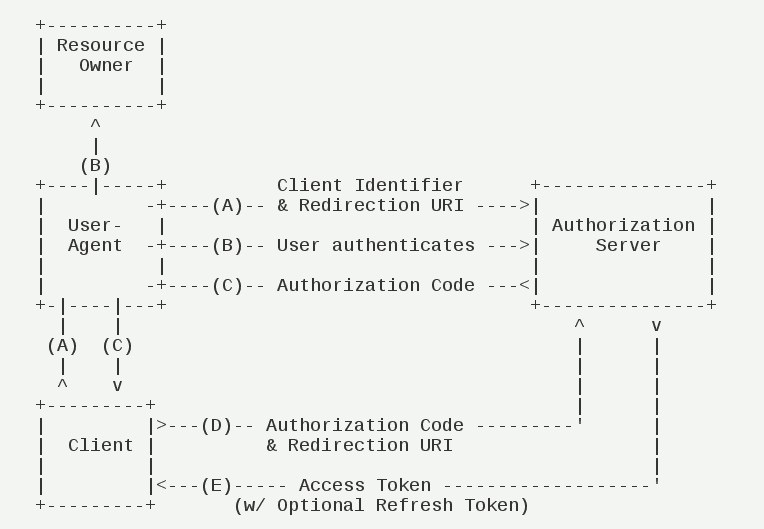oauth简单使用
一、oauth原理参考
二、本例中采用授权码模式

大致流程
(A)用户访问客户端,后者将前者导向认证服务器。
(B)用户选择是否给予客户端授权。
(C)假设用户给予授权,认证服务器将用户导向客户端事先指定的"重定向URI"(redirection URI),同时附上一个授权码。
(D)客户端收到授权码,附上早先的"重定向URI",向认证服务器申请令牌。这一步是在客户端的后台的服务器上完成的,对用户不可见。
(E)认证服务器核对了授权码和重定向URI,确认无误后,向客户端发送访问令牌(access token)和更新令牌(refresh token)。
参数含义
response_type:表示授权类型,必选项,此处的值固定为"code"
client_id:表示客户端的ID,必选项
redirect_uri:表示重定向URI,可选项
scope:表示申请的权限范围,可选项,本例中无
state:表示客户端的当前状态,可以指定任意值,认证服务器会原封不动地返回这个值,本例中无
三、项目中依赖oauth相关jar
<!-- oauth -->
<dependency>
<groupId>org.apache.oltu.oauth2</groupId>
<artifactId>org.apache.oltu.oauth2.resourceserver</artifactId>
<version>${oauth2-version}</version>
</dependency>
<dependency>
<groupId>org.apache.oltu.oauth2</groupId>
<artifactId>org.apache.oltu.oauth2.authzserver</artifactId>
<version>${oauth2-version}</version>
</dependency>
<dependency>
<groupId>org.apache.oltu.oauth2</groupId>
<artifactId>org.apache.oltu.oauth2.client</artifactId>
<version>${oauth2-version}</version>
</dependency>
四、获取授权码
/**
* 获取授权码-服务端
*
* @param request
* @return
* @throws OAuthProblemException
* @throws OAuthSystemException
*/
@RequestMapping(value = "/authorize", method = RequestMethod.GET)
@ResponseBody
public Object authorize(HttpServletRequest request) throws URISyntaxException, OAuthProblemException, OAuthSystemException {
try {
// 构建OAuth授权请求
OAuthAuthzRequest oauthRequest = new OAuthAuthzRequest(request); // 1.获取OAuth客户端id
String clientId = oauthRequest.getClientId();
// 校验客户端id是否正确
LightUserResult lightUserResult = userApi.queryUserByClientId(clientId);
if (null == lightUserResult) {
OAuthResponse response =
OAuthASResponse.errorResponse(HttpServletResponse.SC_BAD_REQUEST)
.setError(OAuthError.TokenResponse.INVALID_CLIENT)
.setErrorDescription("无效的客户端ID")
.buildJSONMessage();
return new ResponseEntity(response.getBody(), HttpStatus.valueOf(response.getResponseStatus()));
} // 2.生成授权码
String authCode = null;
String responseType = oauthRequest.getParam(OAuth.OAUTH_RESPONSE_TYPE);
// ResponseType仅支持CODE和TOKEN
if (responseType.equals(ResponseType.CODE.toString())) {
OAuthIssuerImpl oAuthIssuer = new OAuthIssuerImpl(new MD5Generator());
authCode = oAuthIssuer.authorizationCode();
// 存入缓存中authCode-username
RedisUtil.getRedis().set(authCode, lightUserResult.getUserName());
}
return new ResponseEntity(authCode, HttpStatus.OK);
} catch (Exception e) {
return new ResponseEntity("内部错误", HttpStatus.valueOf(HttpServletResponse.SC_INTERNAL_SERVER_ERROR));
}
}
五、根据授权码获取token
/**
* 获取访问令牌
*
* @param request
* @return
* @throws OAuthProblemException
* @throws OAuthSystemException
*/
@RequestMapping(value = "accessToken", method = RequestMethod.POST)
@ResponseBody
public Object accessToken(HttpServletRequest request) throws OAuthProblemException, OAuthSystemException {
try {
// 构建OAuth请求
OAuthTokenRequest tokenRequest = new OAuthTokenRequest(request); // 1.获取OAuth客户端id
String clientId = tokenRequest.getClientId();
// 校验客户端id是否正确
LightUserResult lightUserResult = userApi.queryUserByClientId(clientId);
if (null == lightUserResult) {
OAuthResponse oAuthResponse = OAuthResponse
.errorResponse(HttpServletResponse.SC_BAD_REQUEST)
.setError(OAuthError.TokenResponse.INVALID_CLIENT)
.setErrorDescription("无效的客户端ID")
.buildJSONMessage();
return new ResponseEntity(oAuthResponse.getBody(), HttpStatus.valueOf(oAuthResponse.getResponseStatus()));
} // 2.检查客户端安全key是否正确
if (!lightUserResult.getClientSecret().equals(tokenRequest.getClientSecret())) {
OAuthResponse oAuthResponse = OAuthResponse
.errorResponse(HttpServletResponse.SC_UNAUTHORIZED)
.setError(OAuthError.TokenResponse.UNAUTHORIZED_CLIENT)
.setErrorDescription("客户端安全key认证不通过")
.buildJSONMessage();
return new ResponseEntity<>(oAuthResponse.getBody(), HttpStatus.valueOf(oAuthResponse.getResponseStatus()));
} // 3.检查授权码是否正确
String authCode = tokenRequest.getParam(OAuth.OAUTH_CODE);
// 检查验证类型,此处只检查AUTHORIZATION_CODE类型,其他的还有password或REFRESH_TOKEN
if (!tokenRequest.getParam(OAuth.OAUTH_GRANT_TYPE).equals(GrantType.AUTHORIZATION_CODE.toString())) {
if (null == RedisUtil.getRedis().get(authCode)) {
OAuthResponse response = OAuthASResponse
.errorResponse(HttpServletResponse.SC_BAD_REQUEST)
.setError(OAuthError.TokenResponse.INVALID_GRANT)
.setErrorDescription("授权码错误")
.buildJSONMessage();
return new ResponseEntity(response.getBody(), HttpStatus.valueOf(response.getResponseStatus())); }
} // 4.生成访问令牌Access Token
OAuthIssuer oAuthIssuer = new OAuthIssuerImpl(new MD5Generator());
final String accessToken = oAuthIssuer.accessToken();
// 将访问令牌加入缓存:accessToken-username
RedisUtil.getRedis().set(accessToken, lightUserResult.getUserName()); // 5.生成OAuth响应
OAuthResponse response = OAuthASResponse
.tokenResponse(HttpServletResponse.SC_OK)
.setAccessToken(accessToken)
.setExpiresIn(expiresIn)
.buildJSONMessage(); return new ResponseEntity(response.getBody(), HttpStatus.valueOf(response.getResponseStatus()));
} catch (Exception e) {
e.printStackTrace();
return new ResponseEntity("内部错误", HttpStatus.valueOf(HttpServletResponse.SC_INTERNAL_SERVER_ERROR));
} }
六、简单测试
@RequestMapping("authority")
@ResponseBody
public JSONObject authority() throws OAuthSystemException, OAuthProblemException {
JSONObject result = new JSONObject();
OAuthClient oAuthClient = new OAuthClient(new URLConnectionClient());
OAuthClientRequest codeTokenRequest = OAuthClientRequest
.authorizationLocation("http://127.0.0.1:8080/auth-web/oauth/authorize")
.setResponseType(ResponseType.CODE.toString())
.setClientId("c1ebe466-1cdc-4bd3-ab69-77c3561b9dee")
.buildQueryMessage();
//获取 code
OAuthResourceResponse codeResponse = oAuthClient.resource(
codeTokenRequest, OAuth.HttpMethod.GET, OAuthResourceResponse.class);
if(codeResponse.getResponseCode() != HttpServletResponse.SC_OK) {
result.put("code", codeResponse.getResponseCode());
result.put("msg", codeResponse.getBody());
} else {
String authCode = codeResponse.getBody();
OAuthClientRequest accessTokenRequest = OAuthClientRequest
.tokenLocation("http://127.0.0.1:8080/auth-web/oauth/accessToken")
.setGrantType(GrantType.AUTHORIZATION_CODE)
.setClientId("c1ebe466-1cdc-4bd3-ab69-77c3561b9dee").setClientSecret("d8346ea2-6017-43ed-ad68-19c0f971738b")
.setCode(authCode).setRedirectURI("http://127.0.0.1:8080/auth-web/")
.buildQueryMessage();
//获取access token
OAuthAccessTokenResponse tokenResponse =
oAuthClient.accessToken(accessTokenRequest, OAuth.HttpMethod.POST);
if(tokenResponse.getResponseCode() != HttpServletResponse.SC_OK) {
result.put("code", tokenResponse.getResponseCode());
result.put("msg", tokenResponse.getBody());
return result;
} else {
//验证token
OAuthClientRequest validateRequest =
new OAuthBearerClientRequest("http://127.0.0.1:8080/auth-web/oauth/validate")
.setAccessToken(tokenResponse.getAccessToken()).buildQueryMessage();
OAuthResourceResponse validateResponse = oAuthClient.resource(
validateRequest, OAuth.HttpMethod.GET, OAuthResourceResponse.class);
if(validateResponse.getResponseCode() != HttpServletResponse.SC_OK) {
result.put("code", validateResponse.getResponseCode());
result.put("msg", validateResponse.getBody());
} else {
JSONObject body = JSON.parseObject(validateResponse.getBody());
result.put("code", body.getString("code"));
result.put("msg", body.getString("msg"));
}
}
}
return result;
}
public static ResponseEntity oauthValidate(HttpServletRequest request) throws OAuthProblemException, OAuthSystemException {
// 构建OAuth资源请求
OAuthAccessResourceRequest resourceRequest = new OAuthAccessResourceRequest(request, ParameterStyle.QUERY);
// 获取访问令牌access Token
String accessToken = resourceRequest.getAccessToken();
// 验证访问令牌
if (null == RedisUtil.getRedis().get(accessToken)) {
// 如果不存在或过期了,返回未验证错误,需重新验证
OAuthResponse response = OAuthRSResponse
.errorResponse(HttpServletResponse.SC_UNAUTHORIZED)
.setError(OAuthError.ResourceResponse.INVALID_TOKEN)
.setErrorDescription("访问令牌不存在或已过期,请重新验证")
.buildJSONMessage();
return new ResponseEntity(response.getBody(), HttpStatus.valueOf(response.getResponseStatus()));
}
return new ResponseEntity("验证成功", HttpStatus.valueOf(HttpServletResponse.SC_OK));
}
七、项目地址
oauth简单使用的更多相关文章
- 基于 OAuth 安全协议的 Java 应用编程1
原文地址:http://www.ibm.com/developerworks/cn/java/j-lo-oauth/index.html 參考博客:http://www.cnblogs.com/wan ...
- 单点登录 之 OAuth
OAuth2.0是什么 OAuth2.0是什么——豆瓣和QQ的故事 OAuth简单说就是一种授权的协议,只要授权方和被授权方遵守这个协议去写代码提供服务,那双方就是实现了OAuth模式. 举个例子,你 ...
- 简单搞懂OAuth2.0
本文转自:https://www.cnblogs.com/flashsun/p/7424071.html 原作者:闪客sun 一张图搞定OAuth2.0 目录 1.引言 2.OAuth2.0是什么 3 ...
- 秒懂OAuth2.0
1.引言 本篇文章是介绍OAuth2.0中最经典最常用的一种授权模式:授权码模式 非常简单的一件事情,网上一堆神乎其神的讲解,让我不得不写一篇文章来终结它们. 一项新的技术,无非就是了解它是什么,为什 ...
- 一张图搞定OAuth2.0
1.引言 本篇文章是介绍OAuth2.0中最经典最常用的一种授权模式:授权码模式 非常简单的一件事情,网上一堆神乎其神的讲解,让我不得不写一篇文章来终结它们. 一项新的技术,无非就是了解它是什么,为什 ...
- 2018/04/14 理解oAuth2.0
最近都近没有更新博客了,卡在 oAuth 上了. 之前公司做统一身份的认证,不了解 oAuth 的我在这卡了两天. 于是决定仔细研究原理,理论指导实践. -- 什么是 oAuth ? 简单来说 oAu ...
- 单点登录系统cas资料汇总
http://jasig.github.io/cas/4.0.x/index.html 主页 https://jasigcas.herokuapp.com ...
- 一张图搞定OAuth2.0 在Office应用中打开WPF窗体并且让子窗体显示在Office应用上 彻底关闭Excle进程的几个方法 (七)Net Core项目使用Controller之二
一张图搞定OAuth2.0 目录 1.引言 2.OAuth2.0是什么 3.OAuth2.0怎么写 回到顶部 1.引言 本篇文章是介绍OAuth2.0中最经典最常用的一种授权模式:授权码模式 非常 ...
- Auth2.0 例子【转载】
本文转载自:https://www.cnblogs.com/flashsun/p/7424071.html 1.引言 本篇文章是介绍OAuth2.0中最经典最常用的一种授权模式:授权码模式 非常简单的 ...
随机推荐
- servlet的过滤器的doFilter()
doFilter中的chain.doFilter(res,req);//Filter 只是链式处理,请求依然转发到目的地址 意思就说过滤器只是一个关口,如果符合条件的请求会被过滤器拦截下来,然后进行处 ...
- Telnet的开启及使用
1首先在控制面板找到程序和功能,双击点开. 2,点击打开或关闭WINDOWS功能 3勾选上这两项 点击确定即可. ------------------------------------------- ...
- nginx+tomcat集群负载均衡(实现session复制)
转自:http://talangniao.iteye.com/blog/341512 架构描述 前端一台nginx服务器做负载均衡器,后端放N台tomcat组成集群处理服务,通过nginx转发到后面( ...
- java集合(1)- 类底层数据结构分析
Java 集合类图 参考:http://www.cnblogs.com/xwdreamer/archive/2012/05/30/2526822.html
- Maven学习(五)
使用Maven构建多模块项目 一般的web项目构成: 建立解决方案目录parent 首先使用命令进入到我们需要建立maven项目的目录: mvn archetype:generate -DgroupI ...
- java中文件操作《一》
在日常的开发中我们经常会碰到对文件的操作,在java中对文件的操作都在java.io包下,这个包下的类有File.inputStream.outputStream.FileInputStream.Fi ...
- docker安装与学习
docker学习 以ubuntu为实例 第一步检查系统内核>3.80 第二步 安装Docker 之前先更新apt-get update 在执行安装命令 apt-get install -y do ...
- div,css命名规范!
命名规则说明: 1).所有的命名最好都小写 2).属性的值一定要用双引号("")括起来,且一定要有值如class="pcss5",id="pcss5& ...
- 关于 vue-cli v2.8.2
我在撰写<Vue2实践揭秘>时采用的 vue-cli 版本是 v2.5.1,由于实体书的出版周期比电子书的要长,所以到全书出版vue-cli已经更新到 v2.8.2 了,我在书中曾经对 v ...
- cpp(第十三章)
1.动态(晚期)联编需要显示定义复制构造函数,赋值运算符,虚构函数. 2.纯虚类不能声明对象. 3.赋值运算符的特征标随类而异. 4.返回类型协变,重新定义继承的方法,应确保与原来的原型完全相同,但如 ...
